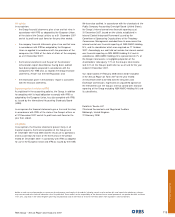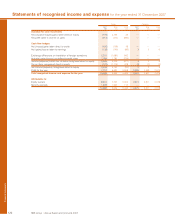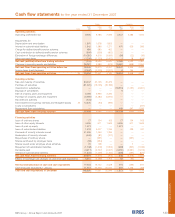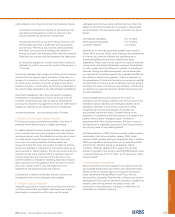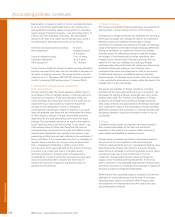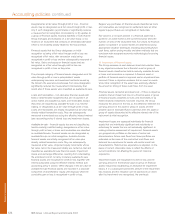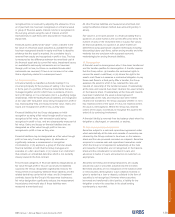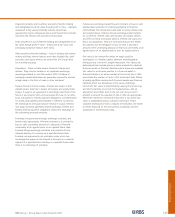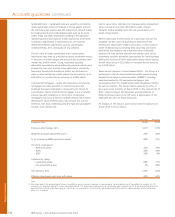RBS 2007 Annual Report Download - page 129
Download and view the complete annual report
Please find page 129 of the 2007 RBS annual report below. You can navigate through the pages in the report by either clicking on the pages listed below, or by using the keyword search tool below to find specific information within the annual report.
127
RBS Group • Annual Report and Accounts 2007
Financial statements
10. Insurance
General insurance
General insurance comprises short-duration contracts,
principally property and liability insurance contracts. Due to
the nature of the products sold – retail-based property and
casualty, motor, home and personal health insurance contracts
– the insurance protection is provided on an even basis
throughout the term of the policy.
Premiums from general insurance contracts are recognised in
the accounting period in which they begin. Unearned
premiums represent the proportion of the net premiums that
relate to periods of insurance after the balance sheet date and
are calculated over the period of exposure under the policy, on
a daily basis, 24th’s basis or allowing for the estimated
incidence of exposure under policies which are longer than
twelve months. Provision is made where necessary for the
estimated amount of claims over and above unearned
premiums including that in respect of future written business
on discontinued lines under the run-off of delegated
underwriting authority arrangements. The provision is designed
to meet future claims and related expenses and is calculated
across related classes of business on the basis of a separate
carry forward of deferred acquisition expenses after making
allowance for investment income.
Acquisition expenses relating to new and renewed business
for all classes are expensed over the period during which the
premiums are earned. The principal acquisition costs so
deferred are commissions payable, costs associated with the
telesales and underwriting staff and prepaid claims handling
costs in respect of delegated claims handling arrangements
for claims which are expected to occur after the balance sheet
date. Claims and the related reinsurance are recognised in the
accounting period in which the loss occurs. Provision is made
for the full cost of settling outstanding claims at the balance
sheet date, including claims estimated to have been incurred
but not yet reported at that date, and claims handling
expenses. The related reinsurance receivable is recognised at
the same time.
Life assurance
The Group’s long-term assurance contracts include whole-life
term assurance, endowment assurance, flexible whole-life,
pension and annuity contracts that are expected to remain in
force for an extended period of time. Long-term assurance
contracts under which the Group does not accept significant
insurance risk are classified as financial instruments.
The Group recognises the value of in-force long-term
assurance contracts as an asset. Cash flows associated with
in-force contracts and related assets, including reinsurance
cash flows, are projected, using appropriate assumptions as to
future mortality, persistency and levels of expenses and
excluding the value of future investment margins, to estimate
future surpluses attributable to the Group. These surpluses,
discounted at a risk-adjusted rate, are recognised as a
separate asset. Changes in the value of this asset are included
in profit or loss.
Premiums on long-term insurance contracts are recognised as
income when receivable. Claims on long-term insurance
contracts reflect the cost of all claims arising during the year,
including claims handling costs. Claims are recognised when
the Group becomes aware of the claim.
Reinsurance
The Group has reinsurance treaties that transfer significant
insurance risk. Liabilities for reinsured contracts are calculated
gross of reinsurance and a separate reinsurance asset
recorded.
11. Taxation
Provision is made for taxation at current enacted rates on
taxable profits, arising in income or in equity, taking into
account relief for overseas taxation where appropriate.
Deferred taxation is accounted for in full for all temporary
differences between the carrying amount of an asset or liability
for accounting purposes and its carrying amount for tax
purposes, except in relation to overseas earnings where
remittance is controlled by the Group, and goodwill.
Deferred tax assets are only recognised to the extent that it is
probable that they will be recovered.
12. Financial assets
On initial recognition financial assets are classified into held-
to-maturity investments; available-for-sale financial assets; held-
for-trading; designated as at fair value through profit or loss; or
loans and receivables.
Held-to-maturity investments – a financial asset may be
classified as a held-to-maturity investment only if it has fixed or
determinable payments, a fixed maturity and the Group has the
positive intention and ability to hold to maturity. Held-to-maturity
investments are initially recognised at fair value plus directly
related transaction costs. They are subsequently measured at
amortised cost using the effective interest method (see
accounting policy 3 above) less any impairment losses.
Held-for-trading – a financial asset is classified as held-for-
trading if it is acquired principally for the purpose of selling in
the near term, or forms part of a portfolio of financial
instruments that are managed together and for which there is
evidence of short-term profit taking, or it is a derivative (not in
a qualifying hedge relationship). Held-for-trading financial
assets are recognised at fair value with transaction costs being
recognised in profit or loss. Subsequently they are measured
at fair value. Gains and losses on held-for-trading financial
assets are recognised in profit or loss as they arise.




